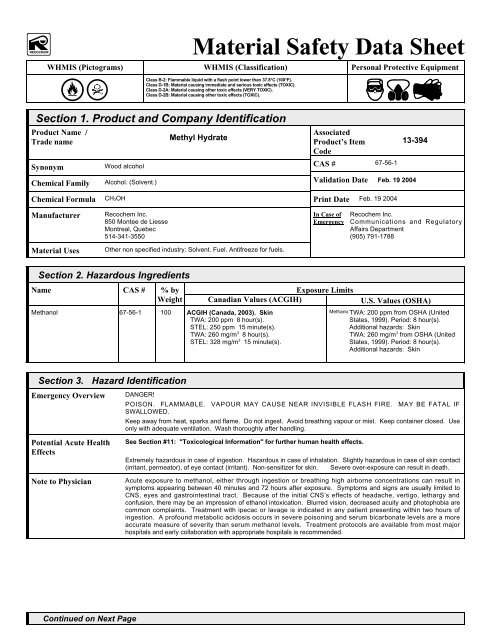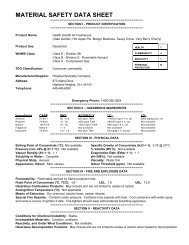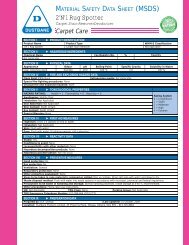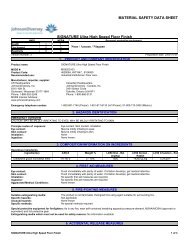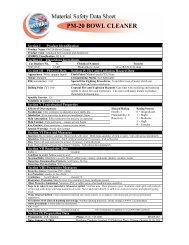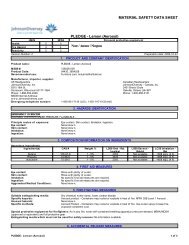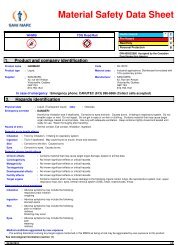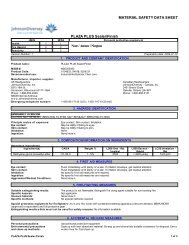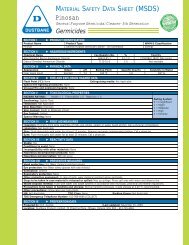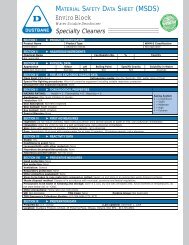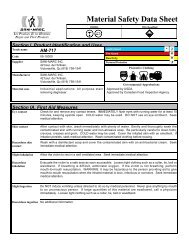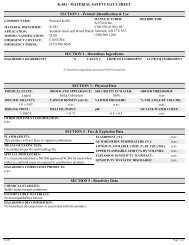Methyl Hydrate - Mathisons
Methyl Hydrate - Mathisons
Methyl Hydrate - Mathisons
- No tags were found...
You also want an ePaper? Increase the reach of your titles
YUMPU automatically turns print PDFs into web optimized ePapers that Google loves.
Material Safety Data SheetWHMIS (Pictograms) WHMIS (Classification) Personal Protective EquipmentClass B-2: Flammable liquid with a flash point lower than 37.8°C (100°F).Class D-1B: Material causing immediate and serious toxic effects (TOXIC).Class D-2A: Material causing other toxic effects (VERY TOXIC).Class D-2B: Material causing other toxic effects (TOXIC).Section 1. Product and Company IdentificationMethanolProduct Name /Trade nameSynonymChemical FamilyWood alcoholAlcohol. (Solvent.)AssociatedProduct’s ItemCodeCAS #METHANOL67-56-1Validation Date 2/19/2004.Chemical FormulaCH3OHPrint Date2/19/2004.ManufacturerMaterial UsesRecochem Inc.850 Montee de LiesseMontreal, Quebec514-341-3550Other non specified industry: Solvent. Fuel. Antifreeze for fuels.In Case ofEmergencyRecochem Inc.Communications and RegulatoryAffairs Department(905) 791-1788Section 2. Hazardous IngredientsName CAS # % byWeightExposure LimitsCanadian Values (ACGIH)Methanol 67-56-1 100 ACGIH (Canada, 2003). SkinTWA: 200 ppm 8 hour(s).STEL: 250 ppm 15 minute(s).TWA: 260 mg/m 3 8 hour(s).STEL: 328 mg/m 3 15 minute(s).U.S. Values (OSHA)MethanolTWA: 200 ppm from OSHA (UnitedStates, 1999). Period: 8 hour(s).Additional hazards: SkinTWA: 260 mg/m 3 from OSHA (UnitedStates, 1999). Period: 8 hour(s).Additional hazards: SkinSection 3. Hazard IdentificationEmergency OverviewPotential Acute HealthEffectsNote to PhysicianDANGER!POISON. FLAMMABLE. VAPOUR MAY CAUSE NEAR INVISIBLE FLASH FIRE. MAY BE FATAL IFSWALLOWED.Keep away from heat, sparks and flame. Do not ingest. Avoid breathing vapour or mist. Keep container closed. Useonly with adequate ventilation. Wash thoroughly after handling.See Section #11: "Toxicological Information" for further human health effects.Extremely hazardous in case of ingestion. Hazardous in case of inhalation. Slightly hazardous in case of skin contact(irritant, permeator), of eye contact (irritant). Non-sensitizer for skin. Severe over-exposure can result in death.Acute exposure to methanol, either through ingestion or breathing high airborne concentrations can result insymptoms appearing between 40 minutes and 72 hours after exposure. Symptoms and signs are usually limited toCNS, eyes and gastrointestinal tract. Because of the initial CNS’s effects of headache, vertigo, lethargy andconfusion, there may be an impression of ethanol intoxication. Blurred vision, decreased acuity and photophobia arecommon complaints. Treatment with ipecac or lavage is indicated in any patient presenting within two hours ofingestion. A profound metabolic acidosis occurs in severe poisoning and serum bicarbonate levels are a moreaccurate measure of severity than serum methanol levels. Treatment protocols are available from most majorhospitals and early collaboration with appropriate hospitals is recommended.Continued on Next Page
Validated on 2/19/2004.Section 4. First Aid MeasuresEye ContactSkin ContactInhalationIngestionMethanolPage: 2/5IMMEDIATELY flush eyes with running water for at least 15 minutes, keeping eyelids open. Seek medical attention.Gently and thoroughly wash the contaminated skin with running water and non-abrasive soap. If irritation persists, getmedical attention. Wash contaminated clothing before reusing.Allow the victim to rest in a well ventilated area. Seek medical advice.DO NOT induce vomiting. Have conscious person drink several glasses of water or milk. SEEK IMMEDIATEMEDICAL ATTENTION.Section 5. Fire Fighting MeasuresProducts of CombustionThese products are carbon oxides (CO, CO2).Fire Fighting Mediaand InstructionsFire HazardsExplosion HazardsSMALL FIRE: Use DRY chemicals, CO2, alcohol foam or water spray.LARGE FIRE: Use alcohol foam, water spray or fog. Cool containing vessels with water jet in order to preventpressure build-up, auto-ignition or explosion.Explosive in the form of vapour when exposed to heat or flame. Vapour may travel considerable distance to source ofignition and flash back. When heated to decomposition it emits acrid smoke and irritating fumes.Highly flammable liquid and vapour.Section 6. Accidental Release MeasuresSmall Spill and LeakLarge Spill and LeakDilute with water and mop up, or absorb with an inert dry material and place in an appropriate waste disposalcontainer.Flammable liquid.Keep away from heat. Keep away from sources of ignition. Stop leak if without risk. Absorb with DRY earth, sand orother non-combustible material. Place in appropriate container and dispose of in accordance with regionalregulations.Section 7. Handling and StorageHandlingStorageHandle and open container with care. Avoid all possible sources of ignition (spark or flame). After handling, alwayswash hands thoroughly with soap and water.See Section #10 for applicable incompatible materials.Store and use away from heat, sparks, open flame, or any other ignition source. Keep away from sources of ignition.Keep away from incompatibles. Keep in a cool, well-ventilated place.Section 8. Exposure Controls, Personal ProtectionEngineering ControlsPersonal ProtectionEyesBodyRespiratoryHandsProvide exhaust ventilation or other engineering controls to keep the airborne concentrations of vapors below theirrespective threshold limit value. Ensure that eyewash stations and safety showers are proximal to the work-stationlocation.Splash goggles.No special protective clothing is required.Organic vapour cartridge respirator.Gloves (impervious).Continued on Next Page
Validated on 2/19/2004.MethanolPage: 3/5Section 9. Physical and Chemical PropertiesPhysical State andAppearanceLiquid.OdourAlcohol.Molecular Weight32.04 g/moleTasteNot available.pH (1% Soln/Water)7 [Neutral.]ColourColourless.Boiling/CondensationPoint64.5°C (148.1°F)Volatility100% (v/v).Melting/Freezing Point-98°C (-144°F)EvaporationRate2.1 compared to Butyl acetate.Specific Gravity0.79 (Water = 1)OdourThreshold2000 ppmVapour Pressure96 mm of Hg @ 20°C.ViscosityNot available.Vapour Density1.11 (Air = 1)SolubilitySoluble in water, diethyl ether.VOC Content790 (g/l).OtherPropertiesNot available.The Product is:Flammable.Auto-ignitionTemperature385°C (725°F)Flash PointFlammable LimitsFire Hazards in Presenceof Various SubstancesCLOSED CUP: 11°C (51.8°F). (Tagliabue.)LOWER: 6% UPPER: 36%Highly flammable in presence of open flames and sparks, of heat, of combustible materials.Section 10. Stability and ReactivityStabilityConditions of InstabilityIncompatibility withVarious SubstancesThe product is stable.No additional remark.Slightly reactive to reactive with oxidizing agents, acids, alkalis.Section 11. Toxicological InformationRoutes of EntryToxicity to AnimalsAbsorbed through skin. Eye contact. Inhalation. Ingestion.Acute oral toxicity (LD50): 5600-13000 mg/kg [Rat]Acute dermal toxicity (LD50): 15840 mg/kg [Rabbit]Acute toxicity of the vapor (LC50): 64000 ppm 4 hours [Rat.]Acute Effects on HumansEyesSkinInhalationIngestionSlightly hazardous in case of eye contact (irritant).Very slightly to slightly dangerous in case of skin contact (irritant, permeator). Non-sensitizer for skin. Skininflammation is characterized by itching, scaling, reddening, or, occasionally, blistering.Hazardous in case of inhalation.Extremely hazardous in case of ingestion. May be fatal if swallowed. Ingestion may cause blindness.Continued on Next Page
Validated on 2/19/2004.Packing GroupIIMethanolPage: 5/5Special ProvisionsContainers of 1 L or less ship as:Class: ORM-DName: Consumer CommodityInternational AirTransport Association(IATA)For air shipment classification and associated regulations, please refer to the latest edition ofIATA Dangerous Goods Regulations.Section 15. Other Regulatory Information and PictogramsWHMIS Classification(Canada)Class B-2: Flammable liquid with a flash point lower than 37.8°C(100°F).Class D-1B: Material causing immediate and serious toxic effects(TOXIC).Class D-2A: Material causing other toxic effects (VERY TOXIC).Class D-2B: Material causing other toxic effects (TOXIC).Canada DomesticSubstances List (DSL)StatusHCS Classification(U.S.A.)U.S.A. Regulatory ListsThis product and/ or all of its components are on the DSL.Class: Highly toxic.Class: Flammable liquid having a flash point lower than 37.8°C (100°F).This product and/ or all of its components are on the TSCA inventory list.Hazardous MaterialInformation System(U.S.A.)HealthFlammabilityReactivityPersonal Protection130GNational FireProtectionAssociation(U.S.A.)Health31Flammability0ReactivitySpecific HazardSection 16. Other InformationValidated and verified by Product Development and Technical Coordinator on 2/19/2004. Printed 2/19/2004.Notice to ReaderTo the best of our knowledge, the information contained herein is accurate. However, neither the above named supplier nor any of its subsidiaries assumes any liability whatsoever forthe accuracy or completeness of the information contained herein.Final determination of suitability of any material is the sole responsibility of the user. All materials may present unknown hazards and should be used with caution. Although certainhazards are described herein, we cannot guarantee that these are the only hazards that exist.MSDS are available at www.recochem.com


